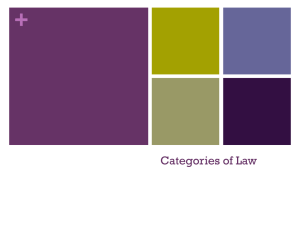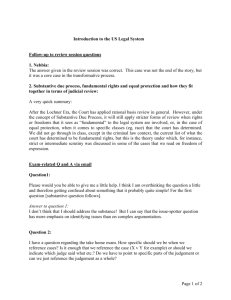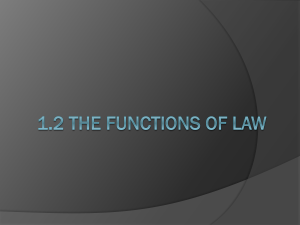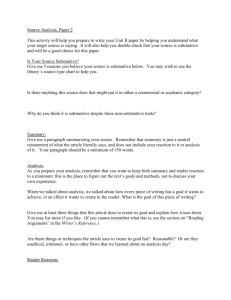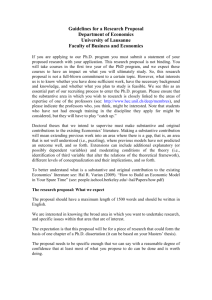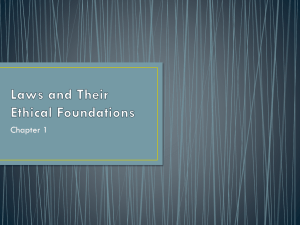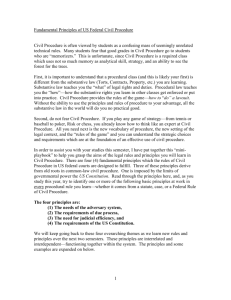320 tremendous, but still only partial, victory for clarity in federal
advertisement
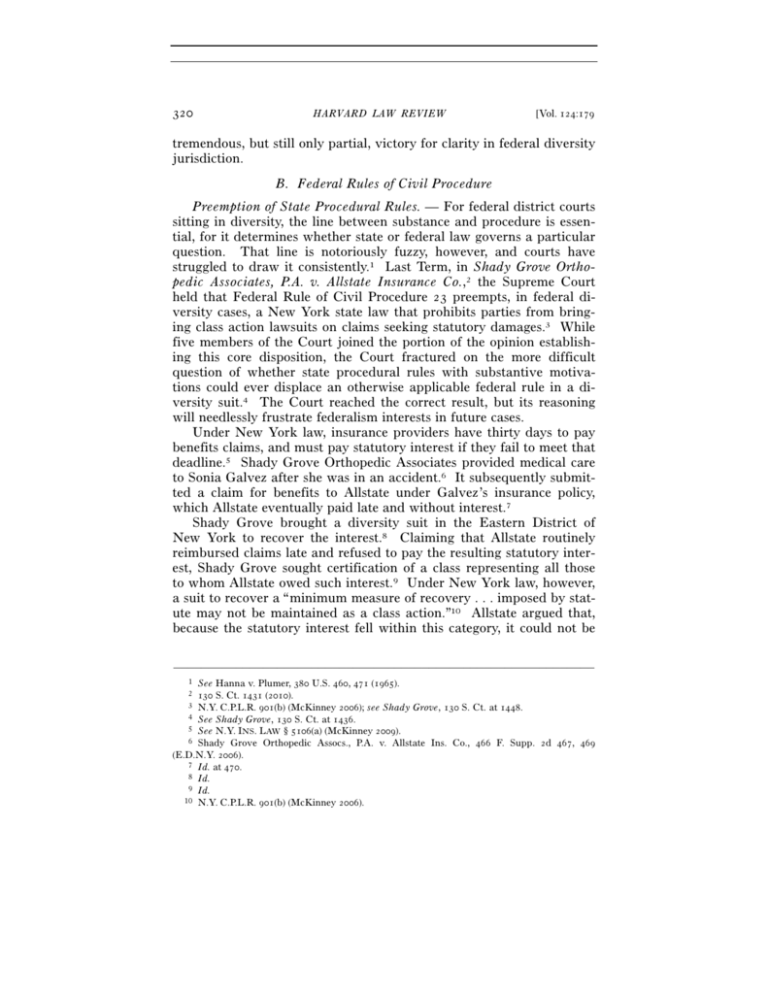
320 HARVARD LAW REVIEW [Vol. 124:179 tremendous, but still only partial, victory for clarity in federal diversity jurisdiction. B. Federal Rules of Civil Procedure Preemption of State Procedural Rules. — For federal district courts sitting in diversity, the line between substance and procedure is essential, for it determines whether state or federal law governs a particular question. That line is notoriously fuzzy, however, and courts have struggled to draw it consistently.1 Last Term, in Shady Grove Orthopedic Associates, P.A. v. Allstate Insurance Co.,2 the Supreme Court held that Federal Rule of Civil Procedure 23 preempts, in federal diversity cases, a New York state law that prohibits parties from bringing class action lawsuits on claims seeking statutory damages.3 While five members of the Court joined the portion of the opinion establishing this core disposition, the Court fractured on the more difficult question of whether state procedural rules with substantive motivations could ever displace an otherwise applicable federal rule in a diversity suit.4 The Court reached the correct result, but its reasoning will needlessly frustrate federalism interests in future cases. Under New York law, insurance providers have thirty days to pay benefits claims, and must pay statutory interest if they fail to meet that deadline.5 Shady Grove Orthopedic Associates provided medical care to Sonia Galvez after she was in an accident.6 It subsequently submitted a claim for benefits to Allstate under Galvez’s insurance policy, which Allstate eventually paid late and without interest.7 Shady Grove brought a diversity suit in the Eastern District of New York to recover the interest.8 Claiming that Allstate routinely reimbursed claims late and refused to pay the resulting statutory interest, Shady Grove sought certification of a class representing all those to whom Allstate owed such interest.9 Under New York law, however, a suit to recover a “minimum measure of recovery . . . imposed by statute may not be maintained as a class action.”10 Allstate argued that, because the statutory interest fell within this category, it could not be ––––––––––––––––––––––––––––––––––––––––––––––––––––––––––––– 1 2 3 4 5 6 See Hanna v. Plumer, 380 U.S. 460, 471 (1965). 130 S. Ct. 1431 (2010). N.Y. C.P.L.R. 901(b) (McKinney 2006); see Shady Grove, 130 S. Ct. at 1448. See Shady Grove, 130 S. Ct. at 1436. See N.Y. INS. LAW § 5106(a) (McKinney 2009). Shady Grove Orthopedic Assocs., P.A. v. Allstate Ins. Co., 466 F. Supp. 2d 467, 469 (E.D.N.Y. 2006). 7 Id. at 470. 8 Id. 9 Id. 10 N.Y. C.P.L.R. 901(b) (McKinney 2006). 2010] THE SUPREME COURT — LEADING CASES 321 sought in a class action in New York state courts.11 Moreover, Allstate argued that section 901(b)’s purpose was primarily substantive and so 901(b) was also binding on federal courts sitting in diversity.12 The district court agreed.13 Finding that section 901(b) applied in diversity suits and could coexist with provision for class certification in Rule 23, it dismissed the class action aspect of the case.14 A Second Circuit panel unanimously affirmed.15 The court acknowledged that direct conflict between a state rule and a Federal Rule of Civil Procedure would generally result in the displacement of the state rule.16 However, the court — agreeing with “[e]very district court to consider this question in any detail” — found that there was no conflict between the two provisions because the state rule was substantive while the federal rule was procedural.17 The Supreme Court reversed.18 Writing for the Court, Justice Sca19 lia reasoned that “Rule 23 provides a one-size-fits-all formula for deciding the class-action question” in all federal cases.20 Rule 23 permits any plaintiff who meets its conditions to bring her claim as a class action.21 A state law that bars such suits therefore squarely conflicts with the procedural right that Rule 23 affords to plaintiffs. Because section 901(b) bars some class actions that Rule 23 would permit, it could apply in diversity suits only if Rule 23 violated the Rules Enabling Act and was therefore ultra vires.22 Justice Scalia rejected Justice Ginsburg’s dissenting argument that section 901(b) did not conflict with Rule 23 because section 901(b) was aimed at answering the question of what relief could be awarded in a class action suit, rather than what claims could be brought as a class action.23 Looking to the text of section 901(b), Justice Scalia observed that “[section] 901(b) says nothing about what remedies a court may award; it prevents the class actions it covers from coming into exis––––––––––––––––––––––––––––––––––––––––––––––––––––––––––––– 11 Shady Grove Orthopedic Assocs., P.A. v. Allstate Ins. Co., 549 F.3d 137, 140–41 (2d Cir. 2008). 12 Shady Grove, 130 S. Ct. at 1443. 13 Shady Grove, 466 F. Supp. 2d at 476. 14 Id. at 475. 15 Shady Grove, 549 F.3d at 146. 16 Id. at 142. 17 Id. at 143. 18 Shady Grove, 130 S. Ct. at 1448. 19 Justice Scalia was joined in full by Chief Justice Roberts and Justice Thomas. Justices Stevens and Sotomayor also joined parts of his opinion, including the portion in which Justice Scalia found that Rule 23 governed the question of what claims could be brought as class action suits in diversity cases. 20 Shady Grove, 130 S. Ct. at 1437. 21 Id. at 1438. 22 See id. at 1437. 23 Id. at 1439. 322 HARVARD LAW REVIEW [Vol. 124:179 tence at all.”24 He criticized Justice Ginsburg’s attempt to determine whether the state legislature’s purpose in enacting the procedural provision was substantive or procedural, writing that such an attempt “is an enterprise destined to produce ‘confusion worse confounded.’”25 It would force district court judges to conduct cumbersome investigations of state legislative history and draw fine lines between those procedural provisions enacted for primarily substantive reasons and those that were truly just procedural.26 Whether the New York legislature’s purpose was substantive or procedural, therefore, the form it adopted was clearly procedural, and thus in conflict with Rule 23. In part of the opinion joined by only three other Justices,27 Justice Scalia analyzed the validity of Rule 23 in light of this conflict. Congress has the power to displace state law (and to delegate that power to courts), even when doing so determines litigation outcomes.28 The relevant question for determining a rule’s validity, then, is whether it remains within the scope of Congress’s delegation in the Rules Enabling Act.29 According to Justice Scalia, Sibbach v. Wilson & Co.30 established that the key to that inquiry is whether the federal rule “really regulat[es] procedure.”31 Rule 23, in Justice Scalia’s view, clearly regulates procedure, and thus falls within the delegation’s scope.32 In light of this conclusion, Justice Scalia deemed it irrelevant whether the state provision was substantive.33 To hold otherwise would make the validity of a federal rule turn on state law, an approach that — according to Justice Scalia — the Court’s precedents decisively foreclosed.34 Instead, the rules are to be assessed facially.35 Justice Scalia conceded that this refusal to look to state law was in tension with the Rules Enabling Act’s language, noting that “it is hard to understand how it can be determined whether a Federal Rule . . . ‘modifies’ substantive rights without knowing what state-created ––––––––––––––––––––––––––––––––––––––––––––––––––––––––––––– 24 25 26 27 28 29 30 31 Id. (footnote omitted). Id. at 1441 (quoting Sibbach v. Wilson & Co., 312 U.S. 1, 14 (1941)). Id. Justice Scalia was joined by Chief Justice Roberts and Justices Thomas and Sotomayor. Shady Grove, 130 S. Ct. at 1442 (plurality opinion). 28 U.S.C. §§ 2071–77 (2006); see Shady Grove, 130 S. Ct. at 1437, 1442. 312 U.S. 1. Shady Grove, 130 S. Ct. at 1442 (plurality opinion) (quoting Sibbach, 312 U.S. at 14) (internal quotation mark omitted). 32 Id. at 1443 (“[A]t least insofar as it allows willing plaintiffs to join their separate claims against the same defendants in a class action . . . [Rule 23] falls within [the Rules Enabling Act’s] authorization.”). 33 Id. at 1444 (“The fundamental difficulty with both these arguments is that the substantive nature of New York’s law, or its substantive purpose, makes no difference.”). 34 Id. (“A Federal Rule of Procedure is not valid in some jurisdictions and invalid in others . . . depending upon whether its effect is to frustrate a state substantive law (or a state procedural law enacted for substantive purposes). That could not be clearer in Sibbach . . . .”). 35 See id. 2010] THE SUPREME COURT — LEADING CASES 323 rights would obtain if the Federal Rule did not exist.”36 Justice Scalia believed that approach was dictated by Sibbach, however, and argued that absent a compelling reason, the Court should not depart from a statutory precedent that Congress has chosen not to change.37 In light of that precedent, and what a majority of the Court saw as a clear conflict between Rule 23 and section 901(b), Justice Scalia (joined by four other Justices) held that Rule 23 governed the availability of a class action in the case and that the lower courts had therefore erred in refusing to certify class status because of section 901(b).38 Justice Stevens joined part of Justice Scalia’s opinion, but concurred to express his disagreement with Justice Scalia’s approach to determining a federal rule’s validity.39 While he agreed that section 901(b) “is not part of New York’s substantive law,” he disagreed that this determination was irrelevant to the analysis of Rule 23’s validity.40 Instead, he argued that, notwithstanding direct conflict with a federal rule, “there are some state procedural rules that federal courts must apply in diversity cases because they function as a part of the State’s definition of substantive rights and remedies.”41 Even if the state provision is nominally procedural, it will still apply in diversity cases (and displace the federal rule) if it is “so bound up with the state-created right or remedy that it defines the scope of that substantive right or remedy.”42 To hold otherwise would be to allow the Federal Rules to “abridge” the substantive state rights given form by that procedural state provision — and therefore violate the Rules Enabling Act.43 Justice Stevens rejected Justice Scalia’s argument that Sibbach had reached this question. The Sibbach petitioner “argued only that federal rules could not validly address subjects involving ‘important questions of policy.’”44 The Court’s holding in rejecting her argument therefore concerned only the facial validity of the federal rule, not its validity in relation to a particular state provision.45 Since Sibbach’s holding had not reached the latter issue, Justice Stevens turned to his best reading of the Rules Enabling Act. That reading required caseby-case analysis of whether the state provision was “so bound up” with substantive rights that displacing it would effectively abridge those ––––––––––––––––––––––––––––––––––––––––––––––––––––––––––––– 36 37 38 39 40 41 42 43 44 Id. at 1445–46. Id. at 1446. Id. at 1438 (majority opinion). Id. at 1448 (Stevens, J., concurring in part and concurring in the judgment). Id. Id. Id. at 1450. Id. at 1451. Id. at 1454 n.11 (quoting Supplemental Brief of Petitioner at 7, Sibbach v. Wilson & Co., 312 U.S. 1 (1941) (No. 28), 1910 WL 21009, at *7). 45 See id. at 1454 & n.11. 324 HARVARD LAW REVIEW [Vol. 124:179 rights.46 Such provisions are uncommon, however, and thus “the bar for finding an Enabling Act problem is a high one.”47 Shady Grove had not met that bar. For one thing, section 901(b) precluded not just class actions that pursued statutory damages under New York law, but rather class actions that pursued statutory damages under any law at all.48 “It is therefore hard to see how [section] 901(b) could be understood as a rule that, though procedural in form, serves the function of defining New York’s rights or remedies.”49 The legislative history, moreover, failed to establish that section 901(b) was adopted for primarily substantive reasons: while legislators intended to prevent overwhelming verdicts on the basis of aggregated statutory damages, they also recognized that statutory damages were less necessary in the class action context (because the purpose of statutory damages is to encourage suits that would otherwise be economically inefficient).50 The legislative history “thus reveals a classically procedural calibration of making it easier to litigate claims . . . only when it is necessary to do so, and not making it too easy when the class tool is not required.”51 Rule 23 thus did not “abridge” any substantive rights and exclusively governed the grounds for class certification in the case. Justice Ginsburg dissented.52 She agreed with Justice Stevens (thus making a majority on this point) that the displaced state provision must be considered in determining whether the federal rule is valid.53 But Justice Ginsburg viewed section 901(b) as substantive, and therefore read Rule 23 narrowly to avoid conflict between the provisions.54 She argued that section 901(b) was focused on the availability of a particular type of damages in class actions, not on what conditions a plaintiff had to meet in order to be eligible for class certification. “In other words, Rule 23 describes a method of enforcing a claim for relief, while [section] 901(b) defines the dimensions of the claim itself.”55 Because she saw no conflict between the provisions, and because she saw section 901(b) as substantive, Justice Ginsburg would have affirmed the lower courts’ holding that section 901(b) precluded the suit. Five Justices, in the concurrence and dissent, agreed that a federal rule’s validity turns, in part, on the content of the state rule that it ––––––––––––––––––––––––––––––––––––––––––––––––––––––––––––– 46 47 48 49 50 51 52 53 54 55 Id. at 1450. Id. at 1457. Id. Id. Id. at 1458–59. Id. at 1459. Justice Ginsburg was joined by Justices Kennedy, Breyer, and Alito. Shady Grove, 130 S. Ct. at 1463 & n.2 (Ginsburg, J., dissenting). See id. at 1465–66. Id. at 1466. 2010] THE SUPREME COURT — LEADING CASES 325 displaces.56 In reaching that conclusion, they adopted the view that a state procedural provision sufficiently “bound up” in substantive policy should displace a contrary federal rule.57 While they were right to look to the state provisions, their approach in doing so will further complicate the analysis required of federal district courts that confront apparent conflicts between a federal rule and a state provision. Moreover, because the analysis that these five Justices endorsed will give federal judges final discretion to determine whether a state law should apply in diversity cases (rather than making the decision turn entirely on the language that the state legislature uses), they actually undermined the federalism values that they intended to protect. The Court should have distinguished or revisited its Sibbach interpretation of the Rules Enabling Act, and it also should have adopted a clear-statement approach that would require state legislatures to clarify whether a particular provision is supposed to apply in diversity cases. Because all the Justices apparently agreed that the best reading of the Rules Enabling Act was that a federal judge must look to state law in determining the validity of the federal rule before her,58 their chief disagreement was whether Sibbach foreclosed this reading. Justice Scalia, focusing on the Court’s statement that “[t]he test must be whether a rule really regulates procedure,”59 argued that it had.60 But as Justice Stevens pointed out, the petitioner there argued not that the right was a “substantive” one under state law, but that it was an especially important procedural right and should thus be considered “substantive” under federal law.61 The Court’s “really regulates procedure” statement, therefore, was made to reject the argument that the importance of the procedural right was relevant; the Court had no occasion to determine whether the nature of a state law right was relevant. Even if one takes Sibbach’s “really regulates procedure” test at face value, it does not follow that the rigorous demands of statutory stare decisis require its continued application.62 Like the Erie decision,63 ––––––––––––––––––––––––––––––––––––––––––––––––––––––––––––– 56 Id. at 1449 (Stevens, J., concurring in part and concurring in the judgment); id. at 1471 (Ginsburg, J., dissenting). 57 Id. at 1450 (Stevens, J., concurring in part and concurring in the judgment); id. at 1463 n.2 (Ginsburg, J., dissenting). 58 See id. at 1445–46 (plurality opinion); id. at 1449 (Stevens, J., concurring in part and concurring in the judgment); id. at 1463 (Ginsburg, J., dissenting). Justice Sotomayor did not join the relevant portion of the plurality's opinion, but there is little reason to believe she would disagree with the other Justices on this issue. 59 Sibbach v. Wilson & Co., 312 U.S. 1, 14 (1941). 60 Shady Grove, 130 S. Ct. at 1445 (plurality opinion). 61 Sibbach, 312 U.S. at 11. 62 See Shady Grove, 130 S. Ct. at 1446 (plurality opinion). 63 Erie R.R. Co. v. Tompkins, 304 U.S. 64 (1938); see RICHARD H. FALLON, JR., ET AL., HART AND WECHSLER’S THE FEDERAL COURTS AND THE FEDERAL SYSTEM 563 (6th ed. 2009). 326 HARVARD LAW REVIEW [Vol. 124:179 Sibbach involves not just the interpretation of a statute but also constitutional issues of federalism and delegation. While Congress undoubtedly has broad power to provide the rules of decision for federal statutory rights, in state law matters “that are brought to federal courts for resolution, Congress only has an undefined power over procedure in federal courts, which is implied from its Article III powers to create such courts.”64 The Rules Enabling Act’s prohibition on rules that “abridge” substantive state rights, therefore, is not just a congressionally imposed limitation; it is also important to the Act’s constitutionality. Were Congress to declare that courts could modify state substantive rights for merely procedural federal purposes, that declaration would raise nontrivial constitutional questions. The modern Court might not actually find such a delegation unconstitutional. For the limited purpose of determining how much weight to afford the precedent, however, the possibility that Sibbach, straightforwardly applied, renders the Rules Enabling Act unconstitutional should be sufficient to merit revisiting the case’s approach to statutory interpretation.65 Where a generally procedural federal rule regulates a substantive right in a particular case, therefore, the Sibbach statement either does not apply or should be rejected. In such a case, the “procedural” rule is not just “really regulat[ing] procedure”; it is also abridging or enlarging substantive rights, in violation of the Rules Enabling Act. Had that been the case in Shady Grove, the Court should have held that Rule 23 exceeded the scope of congressional delegation as applied. But as the majority correctly concluded, the state had chosen to make the right procedural rather than substantive, and therefore Rule 23’s displacement of the state provision was entirely appropriate. The Justices disagreed, though, about how to determine whether the state provision was substantive. Justice Scalia argued that a court should look no further than the face of the state statute.66 Writing for a total of five Justices, however, both Justice Stevens and Justice Ginsburg argued that a facially procedural provision should be considered ––––––––––––––––––––––––––––––––––––––––––––––––––––––––––––– 64 Paul D. Carrington, “Substance” and “Procedure” in the Rules Enabling Act, 1989 DUKE L.J. 281, 285. 65 The straightforward application of Sibbach’s “really regulates procedure” test has also been criticized by commentators. See, e.g., John Hart Ely, The Irrepressible Myth of Erie, 87 HARV. L. REV. 693, 719 (1974). And as Justice Scalia has argued, plain error in constitutional cases ought to be corrected, stare decisis notwithstanding. See Planned Parenthood of Se. Pa. v. Casey, 505 U.S. 833, 983 (1992) (Scalia, J., concurring in the judgment in part and dissenting in part). 66 Shady Grove, 130 S. Ct. at 1440. Justice Scalia believed the substance/procedure distinction was relevant only for determining whether the state and federal rules conflicted. Once such conflict was shown, the nature of the state rule was irrelevant because of his adoption of the “arguably procedural, ergo constitutional” test, Hanna v. Plumer, 380 U.S. 460, 476 (1965) (Harlan, J., concurring), for the validity of a federal rule. See Shady Grove, 130 S. Ct. at 1437–42. 2010] THE SUPREME COURT — LEADING CASES 327 substantive if the judge determined that it was primarily motivated by substantive concerns and closely tied to substantive rights.67 The latter approach is consistent with precedent. In Gasperini v. Center for Humanities, Inc.,68 the provision at issue (providing appellate review of damages) was located in the New York Civil Practice Law and Rules (CPLR), which “govern[s] the procedure in civil judicial proceedings in all courts of the state.”69 Nevertheless, because the provision was in effect a cap on damages, the Court held that the provision was substantive and thus applied in federal diversity suits.70 Just as the Court’s past use of legislative history does not foreclose textualism today,71 however, so too the Court in Shady Grove should have found that a better way to determine the meaning of the state provision was to focus on its wording and placement, rather than the purpose a federal judge ascribes to it. Along with the general advantages of textualism,72 in this particular context — determining whether a state law applies in federal courts sitting in diversity — a textualist approach would have the additional advantage of promoting the federalism values that Justices Stevens and Ginsburg professed to pursue. Because state legislatures would know whether a provision would apply in diversity cases based on its language and placement, they could easily make those decisions at the point of enactment, rather than having a federal judge try to guess at their intentions in a more opaque interpretive regime.73 In effect, the approach proposed here would allow the states to preempt federal procedural rules with their own substantive provisions whenever they expressed that intent with reasonable clarity — but would make such clear expression a requirement.74 While in most contexts such preemption would be unthinkable, it is quite natural in the diversity context, where the federal court is in––––––––––––––––––––––––––––––––––––––––––––––––––––––––––––– 67 See Shady Grove, 130 S. Ct. at 1450 (Stevens, J., concurring in part and concurring in the judgment); id. at 1469–72 (Ginsburg, J., dissenting). 68 518 U.S. 415 (1996). 69 Shady Grove, 130 S. Ct. at 1469 (Ginsburg, J., dissenting) (alteration in original) (quoting Brief for Petitioner at 34, Shady Grove, 130 S. Ct. 1431 (No. 08-1008), 2009 WL 2040421, at *34) (internal quotation marks omitted). Incidentally, section 901(b) is also located in the CPLR. 70 Gasperini, 518 U.S. at 429–31. 71 See Sydney Foster, Should Courts Give Stare Decisis Effect to Statutory Interpretation Methodology?, 96 GEO. L.J. 1863, 1865–66 (2008). 72 See generally Note, Textualism as Fair Notice, 123 HARV. L. REV. 542, 551–57 (2009) (summarizing the literature on the various rationales for textualism). 73 In some cases, direct resort to the text of the state statute would be unnecessary, because the state’s high court would have characterized a provision as substantive or procedural (such as in a horizontal choice-of-law case). In those instances, the state court’s characterization — so long as it was made clearly — would be binding on the federal court. See, e.g., Bush v. Gore, 531 U.S. 98, 112 (2000) (Rehnquist, C.J., concurring); id. at 123 (Stevens, J., dissenting). 74 Cf. Michigan v. Long, 463 U.S. 1032, 1040–41 (1983) (holding that the Court will not review a state court decision that rests on independent state law grounds, but that the state court must specify clearly that it is relying on state law in order to insulate the decision from review). 328 HARVARD LAW REVIEW [Vol. 124:179 volved only to apply state law in a neutral forum and where Congress has decided that rights created by the states should be preserved. Justice Scalia’s statement that “[w]e do Congress no service by presenting it a moving target”75 is even more applicable in the context of states, in which not only democratic legitimacy but also federalism values are at stake. By giving state legislatures one simple rule of construction (“if you say it’s procedural, we’ll believe you, so don’t say it if you don’t mean it”), the Court would have encouraged states to speak clearly to whether they intend a provision to be substantive. New York could have achieved the substantive effect Justice Ginsburg believed it intended with a statute that read, for example, “statutory damages may not be recovered in a class action.”76 Such a provision would be focused on the remedies available in a class action (a substantive question) rather than the procedure used to pursue certain claims, and would thus not conflict with Rule 23.77 This example just shows that ignoring the purported purpose of a procedural provision and looking to its form would do little damage, because states could easily draft statutory language to achieve their desired results. If anything, the approach advocated here would empower states too much, allowing them to discriminate against out-of-state defendants by selectively enforcing substantive goals through procedural methods. In-state defendants (whom in-state plaintiffs could sue only in state court) would receive the benefits of those protections, while out-of-state defendants (who could not remove a case to state court if it was initially filed in federal court) would not.78 But while on its face this semantic gerrymander seems to implicate the antidiscrimination motivations of the Diversity Clause,79 in fact the potential discrimination is of a different sort. The Diversity Clause was intended to ensure a neutral forum,80 not neutral state laws.81 Discrimination against outof-state residents is, instead, prohibited by the Privileges and Immuni- ––––––––––––––––––––––––––––––––––––––––––––––––––––––––––––– 75 76 77 78 Shady Grove, 130 S. Ct. at 1446 (plurality opinion). See id. at 1466–67 (Ginsburg, J., dissenting). See id.; see also id. at 1439 n.4 (majority opinion). This problem is the reverse of the traditional forum shopping concern expressed in Erie and federal rule cases, in which courts feared out-of-state defendants had an unfair advantage because they could choose which law would apply. See, e.g., Black & White Taxicab & Transfer Co. v. Brown & Yellow Taxicab & Transfer Co., 276 U.S. 518, 532–36 (1928) (Holmes, J., dissenting). 79 U.S. CONST. art. III, § 2, cl. 1. 80 See Amanda Frost & Stefanie A. Lindquist, Countering the Majoritarian Difficulty, 96 VA. L. REV. 719, 764 (2010). 81 But see E. Farish Percy, Making a Federal Case of It: Removing Civil Cases to Federal Court Based on Fraudulent Joinder, 91 IOWA L. REV. 189, 198 (2005) (“Many scholars have concluded that this desire to protect creditors from unfavorable state law was the primary reason for creating diversity jurisdiction.”). 2010] THE SUPREME COURT — LEADING CASES 329 ties Clause.82 In order to find such discrimination, however, a court must first hold that there is no “substantial reason for the difference in treatment” and that the discrimination against noncitizens bears no “substantial relationship to the State’s objective.”83 This analysis is more complex than the simplistic “states should not distinguish between citizens and noncitizens” approach that reliance on the purposes of diversity jurisdiction suggests. Courts should not short-circuit the Privileges and Immunities Clause analysis through use of the avoidance canon to find state provisions preempted absent a strong showing that those provisions would otherwise violate Article IV.84 Where a state really was motivated solely by a desire to discriminate against nonresidents, however — which might often be the case when the state stretched its definition of “procedural” beyond any plausible meaning of the term — federal courts could legitimately intercede. Moreover, as the Class Action Fairness Act of 200585 showed, Congress is willing to intervene when state procedures threaten the substantive interests of multistate entities. Indeed, Professor Roderick Hills argues that courts should apply an antipreemption canon of construction because doing so will increase the likelihood of meaningful congressional participation in a particular policy area.86 He argues that if the courts did not enforce a uniform federal rule unless Congress clearly communicated its intention to preempt, the disunity among the states would be likely to prompt powerful lobbyists — multistate entities for whom policy consistency is important — to push the issue onto Congress’s agenda.87 In light of the above-stated constitutional concerns about congressional delegation to courts of the power to make procedural rules that abridge substantive rights, then, a system that encourages congressional involvement in the borderline areas between substance and procedure is desirable. By giving state legislatures more control over the way federal judges classify their statutes for the purpose of determining whether to apply them in diversity cases, and by not allowing the ostensibly pro––––––––––––––––––––––––––––––––––––––––––––––––––––––––––––– 82 See U.S. CONST. art. IV, § 2, cl. 1; Hicklin v. Orbeck, 437 U.S. 518, 524 (1978) (“The purpose of the [Privileges and Immunities] Clause . . . is ‘to place the citizens of each State upon the same footing with citizens of other States . . . . [I]t inhibits discriminating legislation against them by other States . . . .’” (quoting Paul v. Virginia, 75 U.S. (8 Wall.) 168, 180 (1868))). 83 Supreme Court v. Piper, 470 U.S. 274, 284 (1985). 84 Cf. Hiroshi Motomura, Immigration Law After a Century of Plenary Power: Phantom Constitutional Norms and Statutory Interpretation, 100 YALE L.J. 545, 564–65 (1990) (discussing “phantom constitutional norms” that the Court develops in certain areas of law but then applies outside those areas, causing the Court to read statutes in ways that lead to results different from the ones it would reach if it applied the directly applicable constitutional norms). 85 Pub. L. No. 109-2, 119 Stat. 4 (codified in scattered sections of 28 U.S.C.). 86 See Roderick M. Hills, Jr., Against Preemption: How Federalism Can Improve the National Legislative Process, 82 N.Y.U. L. REV. 1, 16–54 (2007). 87 Id. at 17. 330 HARVARD LAW REVIEW [Vol. 124:179 cedural federal rules to displace substantive state provisions, the Court could have promoted the federalism interests around which the Erie line of cases revolves. Instead, the Court’s fractured holding — and even more fractured reasoning — will continue to frustrate litigants and disempower state legislatures. C. Status of International Law Deference to the Executive — Hague Convention on the Civil Aspects of International Child Abduction. — The Hague Convention on the Civil Aspects of International Child Abduction,1 implemented in the United States via the International Child Abduction Remedies Act2 (ICARA), mandates that a child who is “wrongfully” removed from his country of habitual residence be returned to that country.3 This return remedy, however, applies only in cases where the child’s removal violates a parent’s “rights of custody.”4 In contrast, removals that violate a parent’s “rights of access”5 merely authorize that parent to seek a contracting state’s assistance in enforcing his or her visitation rights.6 Last Term, in Abbott v. Abbott,7 the Supreme Court held that a parent’s ne exeat right — the right to prohibit one parent from removing a child from his country of habitual residence without the other parent’s consent — constitutes a right of custody within the meaning of the Convention.8 Although the Court reached a plausible result and resolved the circuit split over the import of ne exeat rights, it missed an important opportunity to clarify how much deference courts should give to the Executive’s interpretation of a treaty’s meaning. The Court’s cursory invocation of executive views in Abbott threatens to move its treaty interpretation jurisprudence toward an ultimately undesirable position of greater deference to the Executive. Timothy Abbott, a British citizen, married Jacquelyn Vaye Abbott, an American citizen, in 1992.9 Their son, A.J. A., was born in Hawaii ––––––––––––––––––––––––––––––––––––––––––––––––––––––––––––– 1 Hague Convention on the Civil Aspects of International Child Abduction, Oct. 25, 1980, 1343 U.N.T.S. 49 [hereinafter Hague Convention]. For background on the Convention and its post-ratification history, see Linda Silberman, The Hague Child Abduction Convention Turns Twenty: Gender Politics and Other Issues, 33 N.Y.U. J. INT’L L. & POL. 221 (2000). 2 42 U.S.C. §§ 11601–11611 (2006). 3 Hague Convention, supra note 1, arts. 1, 3. 4 Id. art. 3. The Convention defines rights of custody to “include rights relating to the care of the person of the child and, in particular, the right to determine the child’s place of residence.” Id. art. 5. 5 Rights of access, according to the Convention, “include the right to take a child for a limited period of time to a place other than the child’s habitual residence.” Id. art. 5. 6 Id. art. 21. 7 130 S. Ct. 1983 (2010). 8 Id. at 1991. 9 Id. at 1988.
